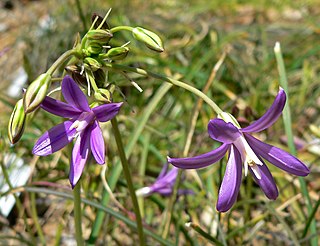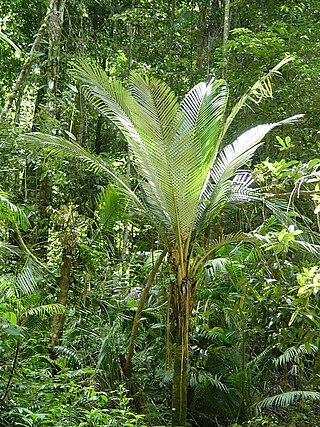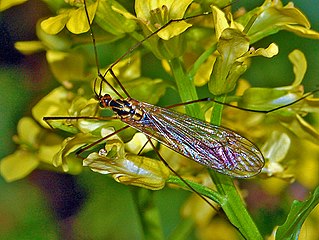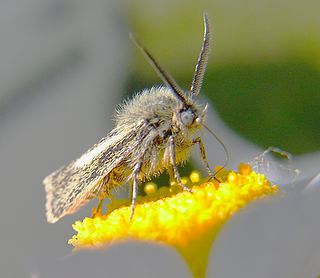
The Cyperaceae are a family of graminoid (grass-like), monocotyledonous flowering plants known as sedges. The family is large, with some 5,500 known species described in about 90 genera, the largest being the "true sedges" genus Carex with over 2,000 species.
There are over 190 vascular plant species on the Norwegian Arctic archipelago of Svalbard. This figure does not include algae, mosses, and lichens, which are non-vascular plants. For an island so far north, this number of species constitutes an astonishing variety of plant life. Because of the harsh climate and the short growing season, all the plants are slow growing. They seldom grow higher than 10 cm (4 in)

Carex is a vast genus of nearly 2,000 species of grass-like plants in the family Cyperaceae, commonly known as sedges. Other members of the family Cyperaceae are also called sedges, however those of genus Carex may be called true sedges, and it is the most species-rich genus in the family. The study of Carex is known as caricology.

Carex flacca, with common names blue sedge, gray carex, glaucous sedge, or carnation-grass,, is a species of sedge native to parts of Europe and North Africa. It is frequent in a range of habitats, including grasslands, moorlands, exposed and disturbed soil, and the upper edges of salt marshes. It has naturalized in eastern North America.

Lambert's Castle is an Iron Age hillfort in the county of Dorset in southwest England. Since 1981 it has been designated as a Site of Special Scientific Interest (SSSI) on account of its geology, archaeology and ecology. The hillfort is designated a scheduled monument together with a bowl barrow, the sites of a post-medieval fair and a telegraph station. The site was on the Heritage at Risk Register but was removed in 2022 as a result of the Hillforts and Habitats Project.

Brodiaea appendiculata, the appendage brodiaea or appendage cluster-lily,) is an uncommon species of plant in the genus Brodiaea.

Oraniopsis is a monotypic genus of flowering plant in the palm family from Queensland, Australia, where the only known species, Oraniopsis appendiculata, grows in mountainous rain forest. Dioecious and extremely slow growing, the name means "similar to Orania" and the Latin epithet translates to "appendaged".

Nephrotoma appendiculata, the spotted crane fly, is a species of crane fly.
Kenneth Kent Mackenzie (1877–1934) was a lawyer and amateur botanist who wrote extensively on the genus Carex in North America. The standard author abbreviation Mack. is used to indicate this person as the author when citing a botanical name.

Carex riparia, the greater pond sedge, is a species of sedge found across Europe and Asia. It grows in a variety of wet habitats, and can be a dominant species in some swamps. It is Britain's largest Carex, growing up to 130 cm tall, with glaucous leaves up to 160 cm long. It hybridises with a number of other Carex species, including the closely related Carex acutiformis – the lesser pond sedge. A variegated cultivar is grown as an ornamental grass.
Nepenthes appendiculata is a tropical pitcher plant known only from the Hose Mountains of central Sarawak, Borneo, where it grows at elevations of 1450–1700 m above sea level. The species is characterised by an enlarged glandular appendage on the lower lid surface, for which it is named.

Cretalamna is a genus of extinct otodontid shark that lived from the latest Early Cretaceous to Eocene epoch. It is considered by many to be the ancestor of the largest sharks to have ever lived, such as Otodus angustidens, Otodus chubutensis, and Otodus megalodon.

Carex sect. Ovales is a section of the genus Carex, containing around 85 species of sedge. It is the most diverse section of the genus in North America, containing 72 species:

Brachodes appendiculata is a moth of the family Brachodidae. It is found in Austria, the Czech Republic, Slovakia, Slovenia, former Yugoslavia, Hungary, Italy, Romania, Ukraine, Russia and the Near East.
James Anderson was a Scottish botanical collector who later became the superintendent of the Sydney Botanic Gardens.

Cremastra appendiculata is an orchid species in the genus Cremastra. It is the type species of its genus.

Carex subg. Vignea is a subgenus of the sedge genus Carex, containing around 300 of the 2000 species in the genus. Its members are characterised by having bisexual, sessile spikes, where the female flowers have two stigmas each.












